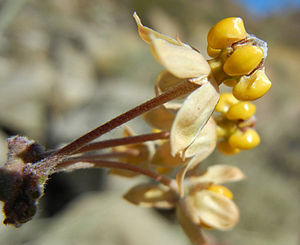Asclepias albicans
| Asclepias albicans | ||||||||||||
|---|---|---|---|---|---|---|---|---|---|---|---|---|

Asclepias albicans |
||||||||||||
| Systematics | ||||||||||||
|
||||||||||||
| Scientific name | ||||||||||||
| Asclepias albicans | ||||||||||||
| S. Watson |
Asclepias albicans is a species of silk plants ( Asclepias ) from the subfamily of the silk plants (Asclepiadoideae).
features
Vegetative characteristics
Asclepias albicans is a bulky, one to three meter high, in exceptional cases up to four meters high shrub with slender, simple or repeatedly branching, woody stem axes . These are covered with a whitish film of thin, flaky wax. Only very young shoots have leaves that are opposite or arranged in groups of three. The leaf blades are linear-thread-shaped, 1 to 3 cm long and less than 1 mm wide. They fall off even before flowering.
Inflorescence and flowers
The many-flowered inflorescences are terminal and arise laterally from the uppermost nodes . They are stalked, the stalks are 1 to 3 cm long and finely hairy. The five-fold hermaphrodite flowers are zygomorphic and have a double flower envelope. The flower stalk is 1 to 2 cm long and also finely hairy. The flower is rather inconspicuous with egg-shaped, approximately 3 mm long sepals that are densely covered with fine woolly hairs. The corolla has curved back, 6 to 7 mm long and pale yellow, greenish or slightly pink-colored petal tips . The greenish-cream-colored or white, rarely also slightly pink-colored corolla has a short stalk, the stalk is narrow, inverted, about 1.5 mm long and 2 mm wide. The tips of the secondary staminal crown are sack-shaped, oblong-rectangular in outline, 2 to 3 mm long, 1.6 to 2.4 mm wide and deeply incised at the upper end. They are about 1 mm shorter than the gynostegium . The horn-shaped secondary process, on the other hand, protrudes over the tips by approx. 2 mm and is fused with the tips. The free end also protrudes over the gynostegium, but is only slightly curved inward. The stylus head is conical with a flattened top, approximately 2 mm long and 3.5 mm wide.
Fruits and seeds
The hanging follicles are narrow, fusiform, long beaten and 9 to 13 cm long with a diameter of 1 cm. They are smooth, very finely hairy when young, later becoming bald. The seeds are egg-shaped, 6 mm long and provided with a pale brown head of hair about 2 cm long.
Similar species
The species is related to Asclepias masonii and Asclepias subaphylla .
Geographical distribution and ecology
The range of the species is limited to dry, desert-like regions in southern California, Arizona and northwestern Mexico. The species grows there on sun-exposed, stony slopes, cliffs, on granitic soils at 150 to 750 m (200 to 1100 m) above sea level. The flowering period is March to June.
Taxonomy and systematics
The taxon was first described by Sereno Watson in 1889. WCSP accepts the taxon as a valid species.
Medical importance
In the folk medicine of Indian tribes in northern Mexico, a tea made from the roots of Asclepias albicans is used against intestinal parasites. The Seri tribe use the tea for headaches.
supporting documents
literature
- Robert E. Woodson, Jr .: The North American Species of Asclepias L. In: Annals of the Missouri Botanical Garden , Vol. 41, No. 1, 1954, pp. 1-211, St. Louis, Mo. URL (pp. 147/8)
- Eric Sundell: Asclepiadaceae Milkweed Family. , In: Journal of the Arizona-Nevada Academy of Science , Vol. 27, No. 2, 1993, pp. 169-187. PDF (p. 173)
- Raymond M. Turner, Janice E. Bowers, Tony L. Burgess: Sonoran Desert plants: an ecological atlas. 504 pp., University of Arizona Press, 2005 Online at Google Books (p. 95)
Individual evidence
- ↑ a b Rafaël Govaerts (ed.): Asclepias. In: World Checklist of Selected Plant Families (WCSP) - The Board of Trustees of the Royal Botanic Gardens, Kew . Retrieved January 3, 2020.
- ^ Sia Morhardt, Emil Morhardt: California desert flowers: an introduction to families, genera, and species. 284 pp., University of California Press, 2004 ISBN 0-520-24002-2 Online at Google Books (p. 26)
- ^ Sereno Watson: Contributions to American Botany. In: Proceedings of the American Academy of Arts and Sciences, Volume 24, 1889, pp. 36-87, Boston. Online at www.biodiversity.org
- ↑ SF Moreno Salazara, RE-Robles Zeped, DE Johnson: Plant folk medicines for gastrointestinal disorders among the main tribes of Sonora, Mexico. In: Fitoterapia , Volume 79, No. 2, 2008, pp. 132-141 doi : 10.1016 / j.fitote.2007.07.009
- ^ Richard S. Felger, Mary Beck Moser: Seri Indian Pharmacopoeia. In: Economic Botany , Volume 28, 1974, pp. 414-436